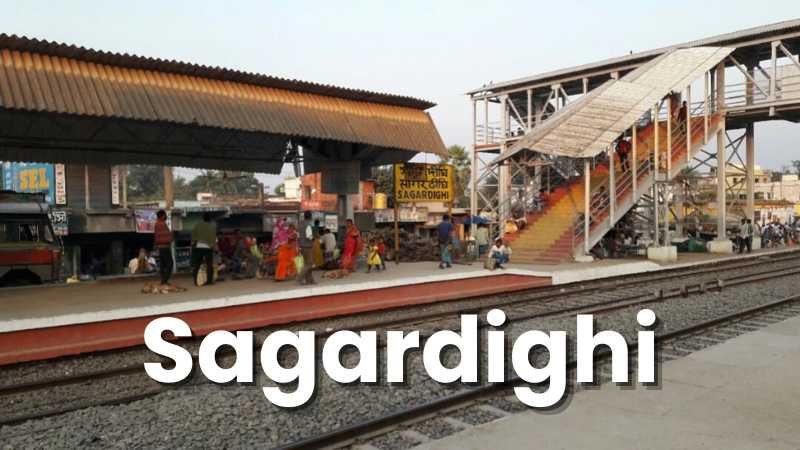Nestled in the heart of West Bengal lies Sagardighi, an assembly constituency that embodies the essence of rural Bengal. With its rich cultural heritage, vibrant traditions, and scenic landscapes, Sagardighi offers a fascinating glimpse into the soul of Bengal. Join me as we embark on a journey to unravel the charm and allure of this quaint constituency.
Sagardighi, Murshidabad, West Bengal, Bharat

- Historical Background: Delving into the history of Sagardighi reveals a tapestry of events that have shaped its identity over the centuries. From ancient kingdoms to colonial rule, Sagardighi has witnessed a myriad of historical transitions. Exploring its historical landmarks, such as ancient temples, colonial-era buildings, and archaeological sites, provides insights into its rich heritage.
- Cultural Heritage: At the heart of Sagardighi’s identity lies its vibrant cultural tapestry. Festivals like Durga Puja, Kali Puja, and Rath Yatra resonate with fervor, uniting communities in celebration. Folk music, dance forms like Baul and Chhau, and traditional art forms adorn the cultural landscape, offering a glimpse into the soul of Bengal.
- Socio-Economic Dynamics: Understanding the socio-economic fabric of Sagardighi sheds light on the challenges and aspirations of its residents. Agriculture forms the backbone of the local economy, with paddy, jute, and sugarcane being prominent crops. However, issues like unemployment, lack of infrastructure, and access to healthcare and education persist, underscoring the need for holistic development initiatives.
- Political Landscape: As an assembly constituency, Sagardighi plays a pivotal role in shaping the political landscape of West Bengal. Over the years, political dynamics have evolved, reflecting the aspirations and concerns of the electorate. From grassroots movements to electoral strategies, politics in Sagardighi is a vibrant tapestry of ideologies and aspirations.
- Environmental Conservation: The natural beauty of Sagardighi is a testament to its ecological richness. The serene lakes, lush greenery, and diverse flora and fauna underscore the need for environmental conservation efforts. Initiatives aimed at preserving the fragile ecosystem, promoting sustainable agriculture, and mitigating climate change are crucial for the long-term well-being of Sagardighi and its inhabitants.
- Future Prospects: As Sagardighi embarks on a journey towards progress and development, it is essential to envision a future that is inclusive and sustainable. Investments in infrastructure, healthcare, education, and skill development hold the key to unlocking the constituency’s potential. Moreover, fostering a culture of innovation and entrepreneurship can empower the local community and drive economic growth.
Conclusion: Sagardighi is more than just an assembly constituency; it is a testament to the resilience, diversity, and spirit of Bengal. As we conclude our journey, let us cherish the memories and experiences shared, and pledge to work towards a brighter, more prosperous future for Sagardighi and its people.
Historical Background:
Delving into the history of Sagardighi unveils a captivating narrative of transformation spanning centuries. Situated in the heart of West Bengal, this constituency has been witness to a rich tapestry of events that have indelibly shaped its identity.
Ancient Kingdoms:
Sagardighi’s history can be traced back to the era of ancient kingdoms that flourished in the region. The remnants of these kingdoms, including ancient ruins and artifacts, offer glimpses into the political and cultural landscape of bygone eras. The rise and fall of dynasties, the confluence of cultures, and the exchange of ideas have left an indelible mark on Sagardighi’s historical trajectory.
Colonial Rule:
With the advent of colonial rule, Sagardighi became a focal point of British administration in Bengal. The region witnessed significant socio-economic changes, as colonial powers introduced new administrative structures, economic policies, and infrastructural developments. The legacy of colonial rule is evident in the architecture of Sagardighi, with colonial-era buildings dotting the landscape, each bearing testimony to a bygone era of imperial dominance.
Exploration of Historical Landmarks:
Exploring Sagardighi’s historical landmarks is akin to embarking on a journey through time. Ancient temples dedicated to Hindu deities, such as Shiva, Kali, and Vishnu, stand as silent sentinels of faith and devotion, reflecting the architectural brilliance of bygone eras. Colonial-era buildings, including administrative offices, churches, and bungalows, offer insights into the colonial legacy that continues to influence the socio-cultural fabric of Sagardighi.
Moreover, archaeological sites scattered across the constituency serve as windows to the past, unraveling mysteries of ancient civilizations and their way of life. From pottery shards to intricate sculptures, each artifact unearthed adds to the mosaic of Sagardighi’s rich heritage, inviting historians and archaeologists to piece together the puzzle of its past.
In essence, Sagardighi’s historical background is a testament to the resilience of its people and the richness of its cultural legacy. By delving into its history and exploring its historical landmarks, one can gain a deeper appreciation for the intricacies of Sagardighi’s identity and its enduring significance in the annals of Bengal’s history.
Cultural Heritage:
At the heart of Sagardighi’s identity lies a vibrant cultural tapestry, woven intricately through centuries of tradition and heritage. The constituency pulsates with the rhythm of festivities, resonating with the fervor of its people and uniting communities in joyous celebration.
Festivals:
Sagardighi comes alive during festivals, which are deeply ingrained in the social fabric of the community. Among the most significant celebrations are Durga Puja, Kali Puja, and Rath Yatra, where elaborate pandals, colorful processions, and enthusiastic participation mark the fervent devotion of the locals. These festivals not only showcase religious fervor but also serve as platforms for social cohesion, fostering bonds of camaraderie and solidarity among diverse communities.
Folk Traditions:
The cultural landscape of Sagardighi is enriched by its vibrant folk traditions, which reflect the ethos and spirit of Bengal. Folk music, characterized by soulful melodies and poignant lyrics, resonates through the villages, echoing the joys and sorrows of rural life. Dance forms like Baul and Chhau captivate audiences with their graceful movements and expressive storytelling, embodying the essence of Bengal’s folk heritage.
Traditional Art Forms:
Sagardighi is adorned with a myriad of traditional art forms that bear testimony to the artistic prowess of its people. From intricate terracotta sculptures adorning temples to vibrant alpana designs adorning courtyards during festivals, each art form reflects the creativity and craftsmanship passed down through generations. The intricate kantha embroidery, clay modeling, and patachitra paintings further enrich the cultural tapestry of Sagardighi, offering a glimpse into the soul of Bengal’s artistic heritage.
In essence, Sagardighi’s cultural heritage is a testament to the resilience and creativity of its people, who continue to cherish and preserve their rich traditions amidst the winds of change. By embracing festivals, folk traditions, and traditional art forms, Sagardighi pays homage to its roots and ensures that its cultural legacy thrives for generations to come.
Socio-Economic Dynamics:
Understanding the socio-economic fabric of Sagardighi unveils a complex interplay of challenges and aspirations that shape the lives of its residents. From the lush fields of agriculture to the pressing needs for infrastructure and social services, Sagardighi’s socio-economic landscape reflects both the strengths and vulnerabilities of its community.
Agriculture as the Backbone:
Agriculture stands as the backbone of Sagardighi’s local economy, with the fertile lands yielding a bounty of crops. Paddy, jute, and sugarcane are among the prominent crops cultivated by local farmers, sustaining livelihoods and driving economic activity. The agrarian heritage of Sagardighi runs deep, embodying the resilience and resourcefulness of its rural populace.
Persistent Challenges:
However, Sagardighi grapples with a myriad of challenges that hinder its socio-economic progress. Unemployment looms large, especially among the youth, exacerbating economic disparities and thwarting aspirations for a better future. Moreover, the lack of adequate infrastructure, including roads, electricity, and irrigation facilities, impedes agricultural productivity and access to markets, limiting economic opportunities for rural communities.
Access to Essential Services:
Access to essential services such as healthcare and education remains a pressing concern in Sagardighi. Despite efforts to improve healthcare facilities and educational institutions, gaps persist, particularly in remote areas. Limited access to quality healthcare services and educational resources hampers the well-being and socio-economic mobility of Sagardighi’s residents, highlighting the need for targeted interventions and investments in social infrastructure.
Holistic Development Initiatives:
Addressing the socio-economic challenges facing Sagardighi requires holistic development initiatives that prioritize inclusive growth and sustainable livelihoods. Investments in agricultural modernization, infrastructure development, and skill enhancement programs can unlock the full potential of Sagardighi’s rural economy, empowering communities and fostering socio-economic resilience. Moreover, initiatives aimed at enhancing access to healthcare, education, and social protection can improve the quality of life and enhance human development outcomes for all residents.
In conclusion, understanding the socio-economic dynamics of Sagardighi is essential for formulating effective policies and interventions that address the needs and aspirations of its residents. By harnessing the strengths of its agrarian economy and investing in social infrastructure, Sagardighi can chart a path towards inclusive and sustainable development, ensuring a brighter future for generations to come.
Political Landscape:
Sagardighi, as an assembly constituency, occupies a significant position in shaping the political landscape of West Bengal. The intricate web of political dynamics woven over the years reflects the aspirations, concerns, and ideologies of its diverse electorate. From grassroots movements to strategic electoral maneuvers, politics in Sagardighi is a vibrant tapestry that mirrors the complexities of Bengal’s socio-political fabric.
Historical Evolution:
The political landscape of Sagardighi has undergone significant evolution over the years, mirroring the broader shifts in West Bengal’s political trajectory. From the dominance of traditional political parties to the emergence of new political formations, Sagardighi has been witness to a kaleidoscope of political movements and realignments. Historical events, socio-economic changes, and cultural dynamics have all shaped the political consciousness of Sagardighi’s electorate, influencing their voting behavior and political affiliations.
Grassroots Movements:
At the heart of Sagardighi’s political landscape are grassroots movements driven by local issues and aspirations. From agrarian movements advocating for land reforms to movements for social justice and empowerment, grassroots activism has played a pivotal role in shaping the socio-political discourse of Sagardighi. These movements, often led by community leaders and activists, reflect the aspirations of marginalized sections of society and serve as catalysts for political change.
Electoral Strategies:
Electoral politics in Sagardighi is characterized by strategic maneuvering and coalition-building, as political parties vie for the support of the electorate. From door-to-door campaigning to large-scale rallies, political parties employ a range of strategies to mobilize voters and sway public opinion. Moreover, alliances and electoral pacts forged between parties further influence the electoral dynamics of Sagardighi, reshaping the contours of political competition.
Ideological Plurality:
The political landscape of Sagardighi is marked by ideological plurality, with a spectrum of political ideologies and affiliations coexisting within the constituency. From leftist ideologies advocating for social justice and equality to right-wing ideologies emphasizing development and governance, Sagardighi embodies a diversity of political thought and expression. This ideological plurality enriches the political discourse, fostering debate, dialogue, and democratic engagement among its citizens.
In essence, the political landscape of Sagardighi is a reflection of the dynamic interplay between history, culture, and socio-economic factors. As the constituency continues to navigate the currents of change, its political landscape remains a vibrant mosaic of aspirations, ideologies, and movements, shaping the trajectory of West Bengal’s political journey.
Environmental Conservation:
The natural beauty of Sagardighi is a treasure trove of ecological richness, where serene lakes, lush greenery, and diverse flora and fauna coalesce to form a harmonious ecosystem. However, this pristine environment is under threat from various anthropogenic activities and climate change. Initiatives aimed at environmental conservation are crucial for safeguarding the long-term well-being of Sagardighi and its inhabitants.
Fragile Ecosystem:
Sagardighi’s ecosystem is delicate and sensitive, vulnerable to the pressures of urbanization, industrialization, and agricultural expansion. The serene lakes, such as Sagardighi Lake itself, serve as vital habitats for migratory birds and aquatic life, while the surrounding forests and wetlands support a rich biodiversity of flora and fauna. Preserving these habitats is essential for maintaining ecological balance and ensuring the sustainability of Sagardighi’s natural environment.
Sustainable Agriculture:
Promoting sustainable agricultural practices is paramount for mitigating the environmental impact of agriculture on Sagardighi’s ecosystem. Implementing techniques such as organic farming, crop rotation, and water-efficient irrigation can help reduce the use of chemical fertilizers and pesticides, minimizing soil erosion and water pollution. Additionally, promoting agroforestry and land-use planning can enhance biodiversity conservation and soil fertility, while providing alternative livelihoods for farmers.
Mitigating Climate Change:
Climate change poses a significant threat to Sagardighi’s environment, exacerbating risks such as extreme weather events, rising temperatures, and erratic rainfall patterns. Mitigating climate change requires a multi-faceted approach, including measures to reduce greenhouse gas emissions, enhance resilience to climate impacts, and promote renewable energy sources. Initiatives such as afforestation, reforestation, and carbon sequestration can help mitigate carbon emissions and enhance the resilience of Sagardighi’s ecosystem to climate change.
Community Participation:
Environmental conservation efforts in Sagardighi must involve active participation and engagement from the local community. Empowering communities through environmental education, awareness campaigns, and capacity-building initiatives can foster a sense of ownership and responsibility towards the conservation of Sagardighi’s natural resources. Additionally, fostering partnerships between government agencies, non-governmental organizations, and local stakeholders can facilitate collaborative efforts towards environmental sustainability.
In conclusion, environmental conservation is integral to ensuring the long-term well-being and sustainability of Sagardighi and its inhabitants. By preserving its fragile ecosystem, promoting sustainable agriculture, and mitigating climate change, Sagardighi can continue to thrive as a haven of ecological richness and natural beauty for generations to come
Future Prospects:
As Sagardighi sets its sights on a path of progress and development, it is imperative to envision a future that is both inclusive and sustainable. By investing in key areas such as infrastructure, healthcare, education, and skill development, Sagardighi can unlock its full potential and pave the way for a brighter tomorrow. Moreover, fostering a culture of innovation and entrepreneurship can empower the local community and drive economic growth, ensuring prosperity for all residents.
Investments in Infrastructure:
Infrastructure development forms the cornerstone of Sagardighi’s future prospects, laying the foundation for economic growth and social progress. Improving road connectivity, expanding access to electricity and clean water, and upgrading digital infrastructure can enhance the quality of life and facilitate socio-economic development. Investments in infrastructure also create employment opportunities and stimulate local businesses, driving overall growth and prosperity.
Enhancing Healthcare and Education:
Access to quality healthcare and education is essential for human development and well-being. By investing in healthcare facilities, medical infrastructure, and trained healthcare professionals, Sagardighi can improve health outcomes and ensure that residents have access to essential healthcare services. Similarly, enhancing educational institutions, promoting vocational training, and supporting lifelong learning initiatives can empower individuals with the skills and knowledge needed to thrive in a rapidly changing world.
Fostering Innovation and Entrepreneurship:
Fostering a culture of innovation and entrepreneurship is crucial for unlocking Sagardighi’s economic potential and driving sustainable development. Encouraging local innovation hubs, supporting startup incubators, and providing access to financial resources and business mentorship can nurture entrepreneurial talent and spur economic diversification. Moreover, promoting value-added industries, such as agro-processing and eco-tourism, can leverage Sagardighi’s natural resources and cultural heritage to create sustainable livelihoods and economic opportunities.
Inclusive and Sustainable Development:
At the heart of Sagardighi’s future prospects lies a commitment to inclusive and sustainable development. Ensuring that development initiatives prioritize the needs of marginalized communities, empower women and youth, and promote social equity is essential for building a resilient and inclusive society. Moreover, adopting sustainable practices, such as renewable energy adoption, waste management, and conservation of natural resources, can safeguard Sagardighi’s environment for future generations.
In conclusion, Sagardighi’s future prospects are bright with potential, poised for progress and prosperity. By investing in infrastructure, healthcare, education, and innovation, while embracing principles of inclusivity and sustainability, Sagardighi can chart a course towards a future that is prosperous, equitable, and sustainable for all its residents.
Frequently Asked Questions About Sagardighi
- What is Sagardighi?
Sagardighi is an assembly constituency located in the Murshidabad district of the Indian state of West Bengal. It is also the name of a town within the constituency.
- What is the significance of Sagardighi in West Bengal politics?
Sagardighi plays a pivotal role in shaping the political landscape of West Bengal due to its active participation in state assembly elections and its representation in the legislative assembly.
- What is the historical background of Sagardighi?
Sagardighi has a rich history dating back to ancient kingdoms and later came under colonial rule. It has historical landmarks such as ancient temples, colonial-era buildings, and archaeological sites.
- What are the major festivals celebrated in Sagardighi?
Sagardighi celebrates festivals like Durga Puja, Kali Puja, Rath Yatra, and others with fervor, which reflect the cultural vibrancy of the constituency.
- What are the main crops cultivated in Sagardighi?
Agriculture is the backbone of Sagardighi’s economy, with crops like paddy, jute, and sugarcane being prominently cultivated.
- What are the socio-economic challenges faced by Sagardighi?
Sagardighi faces challenges such as unemployment, lack of infrastructure, and limited access to healthcare and education, which necessitate holistic development initiatives.
- What is the environmental status of Sagardighi?
Sagardighi boasts a rich ecological diversity with serene lakes, lush greenery, and diverse flora and fauna. However, environmental conservation efforts are required to preserve its fragile ecosystem.
- How does Sagardighi contribute to the cultural heritage of West Bengal?
Sagardighi’s vibrant cultural tapestry, including folk music, dance forms, and traditional art, enriches the cultural heritage of West Bengal.
- What are the future prospects for development in Sagardighi?
Sagardighi’s future prospects include investments in infrastructure, healthcare, education, and skill development, as well as fostering a culture of innovation and entrepreneurship for inclusive and sustainable development.
- Who are the notable historical figures associated with Sagardighi?
Historical figures such as rulers of ancient kingdoms, colonial administrators, and social reformers have left their mark on Sagardighi’s history.
- What are the major industries in Sagardighi?
Sagardighi’s economy is primarily agrarian, but it also has industries such as small-scale manufacturing, handloom, and handicrafts.
- What is the demographic composition of Sagardighi?
Sagardighi has a diverse demographic composition, including various caste, religious, and linguistic communities.
- What are the transportation facilities available in Sagardighi?
Sagardighi has road connectivity and access to public transportation such as buses and trains, facilitating intra-district and inter-district travel.
- How is healthcare infrastructure in Sagardighi?
Sagardighi has healthcare facilities including government hospitals, primary health centers, and private clinics, though there may be gaps in accessibility and quality of services.
- What are the educational institutions in Sagardighi?
Sagardighi has schools, colleges, and vocational training centers catering to the educational needs of its residents.
- How is the water supply and sanitation infrastructure in Sagardighi?
Sagardighi has water supply systems and sanitation facilities, though there may be challenges in ensuring access to clean water and sanitation for all residents.
- Is there a tourism potential in Sagardighi?
Sagardighi’s natural beauty, historical landmarks, and cultural heritage offer tourism potential, though infrastructure and promotional efforts may be needed to tap into this potential fully.
- What are the measures taken for environmental conservation in Sagardighi?
Environmental conservation efforts in Sagardighi include initiatives such as afforestation, waste management, and conservation of water bodies and biodiversity.
- What are the government schemes available for socio-economic development in Sagardighi?
Sagardighi residents may benefit from various government schemes aimed at poverty alleviation, employment generation, skill development, and social welfare.
- Are there any ongoing infrastructure projects in Sagardighi?
Ongoing infrastructure projects in Sagardighi may include road construction, electrification, and water supply projects aimed at improving connectivity and basic amenities.
- How is the law and order situation in Sagardighi?
Sagardighi generally maintains law and order, though occasional incidents of crime may occur, necessitating vigilance and effective policing measures.
- What are the cultural events and festivals unique to Sagardighi?
Sagardighi may have unique cultural events and festivals specific to its local traditions and customs, which contribute to its cultural vibrancy.
- What is the state of women’s empowerment and gender equality in Sagardighi?
Efforts may be underway to promote women’s empowerment and gender equality in Sagardighi through initiatives such as women’s self-help groups, education, and awareness campaigns.
- What are the challenges faced by farmers in Sagardighi?
Farmers in Sagardighi may face challenges such as lack of access to credit, market volatility, and adverse weather conditions, which impact agricultural productivity and livelihoods.
- How can individuals contribute to the development of Sagardighi?
Individuals can contribute to the development of Sagardighi by actively participating in community initiatives, promoting sustainable practices, supporting local businesses, and advocating for their rights and needs.














